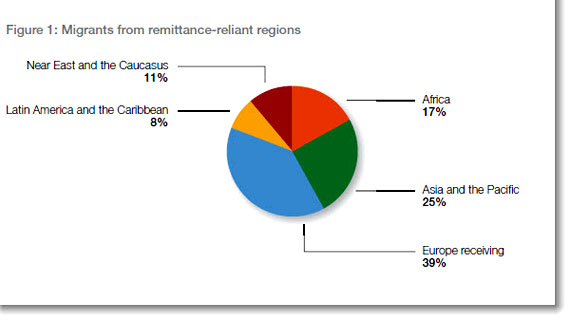
[HOME ] [ABOUT] [PHOTOS] [VIDEO] [BLOG] [HOUSTON] [TEXAS] [U.S. NEWS] [WORLD NEWS] [SPORTS] [POP CULTURE] [CONTACT]
Remittances back home from Europe top over $100 billion

by Joseph Earnest June 15, 2015
Newscast Media ROME—A recent financial report reveals that migrant workers in Europe sent over $100 billion back to their home countries.
Last year migrant workers living in Europe sent home US$109.4 billion in remittances, providing a lifeline to more than 150 million people around the world, according to a report released today by the International Fund for Agricultural Development (IFAD).
While this amount represents a quarter of remittances flows worldwide, one of the key findings of the report is that benefits for families back home could be much higher if they had access to more competitive money transfer markets and targeted financial services to help them save and or invest their funds.
"We need to make sure that this hard-earned money is sent home cheaply but more importantly that it helps families build a better future for themselves, particularly in the poorest rural communities where it counts the most," said Kanayo F. Nwanze, President of IFAD about the report’s findings.

Source: International Fund for Agricultural Development
On the sending end, Western Europe and the Russian Federation were the main source of remittances. The top-six sending countries in 2014 were: the Russian Federation ($20.6 billion), the United Kingdom ($17.1 billion), Germany ($14 billion), France ($10.5 billion), Italy ($10.4 billion) and Spain ($9.6 billion). Together, they accounted for about 75 per cent of all flows from Europe.
Click here to read or download financial report on remittances. (pop-up)
Despite these numbers, remittances did not represent a significant outflow of wealth from these host countries. According to the report, remittances amounted to less than 0.7 per cent of individual country GDP.
On the receiving side, in 2014, about one third or $36.5 billion of European remittances went to 19 countries in the Balkans, the Baltics and Eastern Europe, including 10 EU member states. The remaining two thirds or $72.9 billion went to over 50 developing countries outside Europe.
Of the 19 remittance-receiving countries within
Europe, the report shows that nine countries whose economies are
agriculture-based relied the most on flows from Europe, representing 22
per cent of GDP in Moldova and 17 per cent in Kosovo.
Beyond Europe, Northern Africa and Central Asia were
the regions that were most reliant on European flows, largely from
France and Russia respectively.
At a time when unprecedented numbers of refugees are entering Europe as they flee from conflict, the report also notes that Europe was a source of considerable remittances to fragile states, including Iraq, Mali, Somalia, Sudan, Syria and Yemen and that more could be done to leverage the impact of remittances to help stabilize and rebuild countries.
The majority of remittances received are used for basic goods such as food, clothing, shelter, medicine and education. However, studies indicate that up to 20 per cent of remittances could be available for savings, investments or to repay loans for small businesses.
With 40 percent of remittances go to rural areas, the report also suggests that remittances play a critical role in the transformation of vulnerable communities. In fact, remittances are estimated to equal at least three times official development assistance to developing countries.
"The immense potential of remittances for development is still largely underutilized but it is within our capacity to make every hard-earned euro, ruble, pound, krona, or Swiss franc sent home count even more," said Nwanze.
IFAD estimates that globally $80 billion could be available for investment if migrant workers and receiving families in rural areas were given more options to use their funds. Of that amount, about $34 billion would be available in rural areas.
While significant progress has been made over the last few years to lower transfer costs, De Vasconcelos added that more could be done through increased competition. By reducing transfer costs to 5 per cent, as per the G20 objective set in 2009, an additional $2.5 billion would be saved for migrant workers and their families back home.
Add Comments>>
|
|
Join the Newscast Media social networks
for current events and multimedia content.
Copyright© Newscast Media. All Rights Reserved. Terms and Privacy Policy
